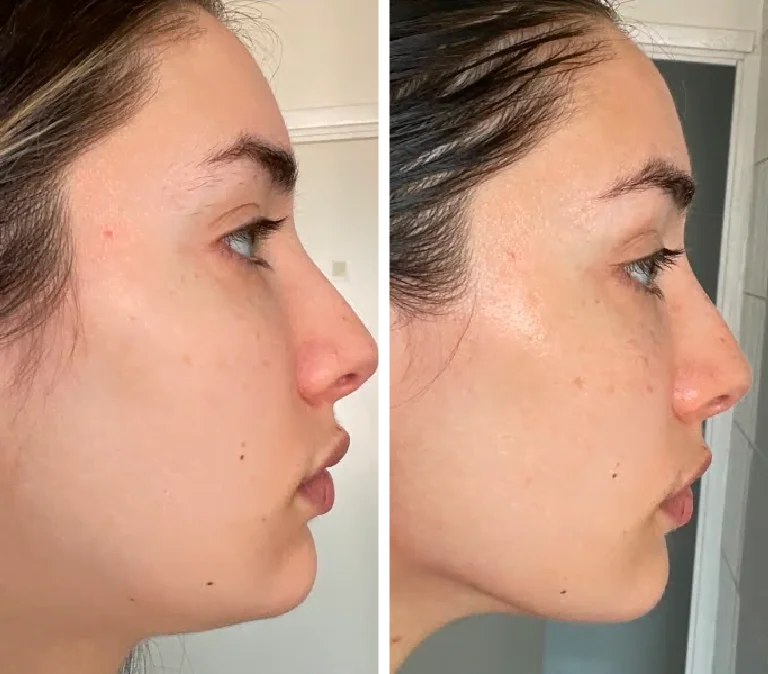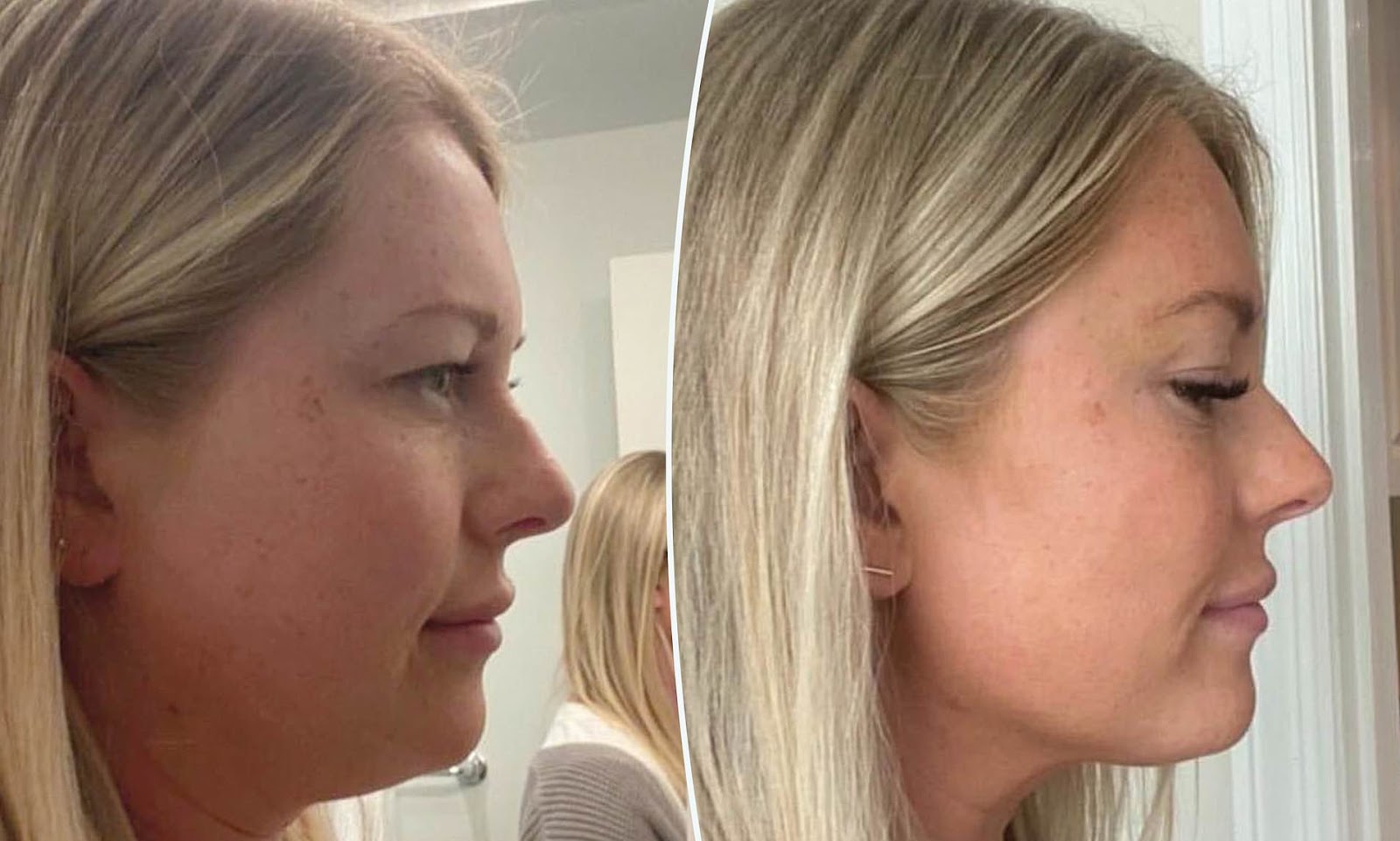Gua sha is a traditional Chinese medicine (TCM) practice that has gained popularity in recent years as a facial massage technique. With claims of improving skin tone and texture, reducing puffiness, and even contouring the face, it’s no wonder that gua sha has become a buzzword in the world of beauty and wellness. But does this ancient practice really work? Can it truly reduce a double chin or slim down the face?
In this article, we will dive into the truth about gua sha and examine its effectiveness for facial sculpting, giving you a better understanding of what to expect from this popular technique.
Gua Sha Before and After review

Stage 1: I experienced a minor breakout
This outcome wasn’t what I anticipated from a soothing skincare treatment. It’s akin to stirring up sediment from the bottom of a pond. When beginning any form of facial massage routine, such as gua sha or lymphatic drainage, breakouts may emerge.
If you, like me, observe breakouts on your face after several days of gua sha, consider adjusting your technique to use downward strokes, starting from the jawline and ending at the clavicle.
Stage 2: I gained a deeper understanding of my facial stress patterns
While I thought I had a decent grasp of my facial tension through daily oil cleansing and massage, gua sha opened up a more nuanced understanding. Running a flat stone over your facial contours provides intricate insights.
With a gua sha stone, you can detect the high points, low points, crevices, and yes, even knots in your face. I tend to hold tension beneath my cheekbones, across my forehead, and along the sides of my face, from my temples to my jawline. As I worked on my forehead lines, feeling the distinct shape of the tissue beneath the skin revealed a lot about how I express and carry stress in my face.
We often hear about understanding how we hold tension in our bodies, but it’s equally valuable to be attuned to how we hold tension in our faces. Regular facial massages can assist in this awareness.
Stage 3: I began focusing more on my neck
I’ve come to believe that anyone embarking on a self-gua sha practice should prioritize neck work, commencing and often concluding with it.
After several consecutive days of gua sha, I noticed a slight swelling beneath my jawline and chin. It’s possible that lymph fluid was accumulating in that area. Starting and ending with gentle strokes down the neck is crucial to maintain proper lymphatic flow..
Does Gua Sha Work?

The million-dollar question: does gua sha actually work? The answer is yes, but with some caveats.
There is limited scientific evidence to support the claims that gua sha works. However, some studies have shown that gua sha may be effective for relieving muscle pain, reducing inflammation, and improving skin tone and texture.
For example, in a study from 2018 featured in the Evidence-Based Complementary and Alternative Medicine journal, gua sha was shown to effectively alleviate muscle pain and stiffness in individuals dealing with chronic neck pain. Similarly, a study from 2021, published in the journal Pain Medicine, demonstrated the effectiveness of gua sha in reducing inflammation and enhancing pain relief and functionality in those suffering from shoulder pain. Furthermore, a study in 2022, published in the Photodermatology, Photoimmunology & Photomedicine journal, confirmed that gua sha yielded positive results in enhancing skin tone and texture among individuals with photoaging.
In fact, these studies were small and short-term. More research is needed to confirm the long-term safety and effectiveness of gua sha for all of its purported benefits.
How Gua Sha Works
Gua sha is based on the principles of traditional Chinese medicine, which believes that energy or qi flows through our bodies. When this flow is disrupted, it can lead to various health issues, including skin problems. Gua sha is said to help restore the flow of qi and promote overall well-being.
When used on the face, gua sha is thought to increase blood circulation, reduce inflammation, and promote lymphatic drainage. This can result in a brighter complexion, reduced puffiness, and a more defined facial structure. The tool’s pressure on the skin also helps to relax tense muscles and release tension, leading to a more rejuvenated appearance.
Gua Sha Before and After Double Chin

One of the most sought-after benefits of gua sha is its potential to reduce a double chin or contour the face for a slimmer appearance. Here’s a closer look at how gua sha can help with these concerns.
Reducing Double Chin
A double chin is caused by excess fat or loose skin under the chin, making the area appear fuller and rounder. It can be challenging to get rid of a double chin as it requires a combination of diet, exercise, and possibly medical procedures. However, incorporating gua sha into your skincare routine may provide some improvements.
Using the gua sha tool to massage the chin and neck area can stimulate blood flow and promote lymphatic drainage, which can help reduce puffiness and improve the appearance of a double chin. Additionally, regular gua sha massages can help to tighten and tone the muscles in the neck and jawline, resulting in a more defined and sculpted appearance over time.
Contouring the Face
Facial contouring has become a popular trend in recent years, with many people seeking ways to achieve a more defined and chiseled facial structure. While there are various techniques and treatments available, gua sha offers a natural and non-invasive option for facial sculpting.
The pressure and movements of the gua sha tool on the face can help to relax tense muscles and release tension, resulting in a more relaxed and defined appearance. Additionally, the increased blood flow and lymphatic drainage can reduce puffiness and improve skin tone, further enhancing the facial contours.
Gua Sha for Face
Now that we’ve established that gua sha can work for reducing a double chin and contouring the face, let’s dive into how to use this technique properly for the best results.
How to Use Gua Sha Stone
First and foremost, it is essential to choose the right gua sha tool for your needs. There are various types of stones available, with jade and rose quartz being the most popular choices. Jade is said to have cooling properties, making it ideal for reducing inflammation and puffiness, while rose quartz is believed to promote self-love and inner peace, making it a popular choice for facial massages.
To use a gua sha stone, start by applying a facial oil or serum to your clean and dry face. This will help the tool glide smoothly on the skin and prevent any discomfort. Hold the gua sha tool at a 15-degree angle and gently scrape it over your face using upward and outward strokes. Use light pressure and move the tool in long, smooth motions, avoiding any areas with moles or blemishes.
For the chin and neck area, start in the center and use upward strokes towards the ears. For the cheekbones, start at the nose and glide towards the temples. When working on the forehead, start from the center and move outwards towards the hairline. Repeat each stroke three to five times, and remember to be gentle as the skin on the face is delicate.
Gua Sha Facial Massage
In addition to using the gua sha tool, incorporating a facial massage into your skincare routine can provide even more benefits. Massaging the face with your hands can help to promote blood circulation, reduce tension, and enhance product absorption. You can use your fingers or a facial roller to massage your face in upward and outward motions, or you can follow a specific gua sha facial chart for a more targeted massage.
Gua Sha Facial Chart
A gua sha facial chart is a visual guide that illustrates which areas of the face to target for different skin concerns. It provides a step-by-step guide for using the gua sha tool to achieve specific results. Here’s an example of a gua sha facial chart for facial sculpting:

As you can see from the chart, there are specific strokes and pressure points to target for each area of concern. This can be helpful for those new to gua sha and looking for guidance on how to use the tool effectively.
Final Takeaway
In conclusion, gua sha may not be a miracle cure for all skin concerns, it can provide noticeable improvements in skin health and appearance when used properly and consistently.
From reducing puffiness and promoting lymphatic drainage to contouring the face and reducing a double chin, gua sha has many potential benefits. By incorporating this ancient practice into your skincare routine and following a gua sha facial chart, you can achieve a brighter complexion, defined facial contours, and a more relaxed and rejuvenated appearance. So why not give gua sha a try and see the before and after results for yourself?




